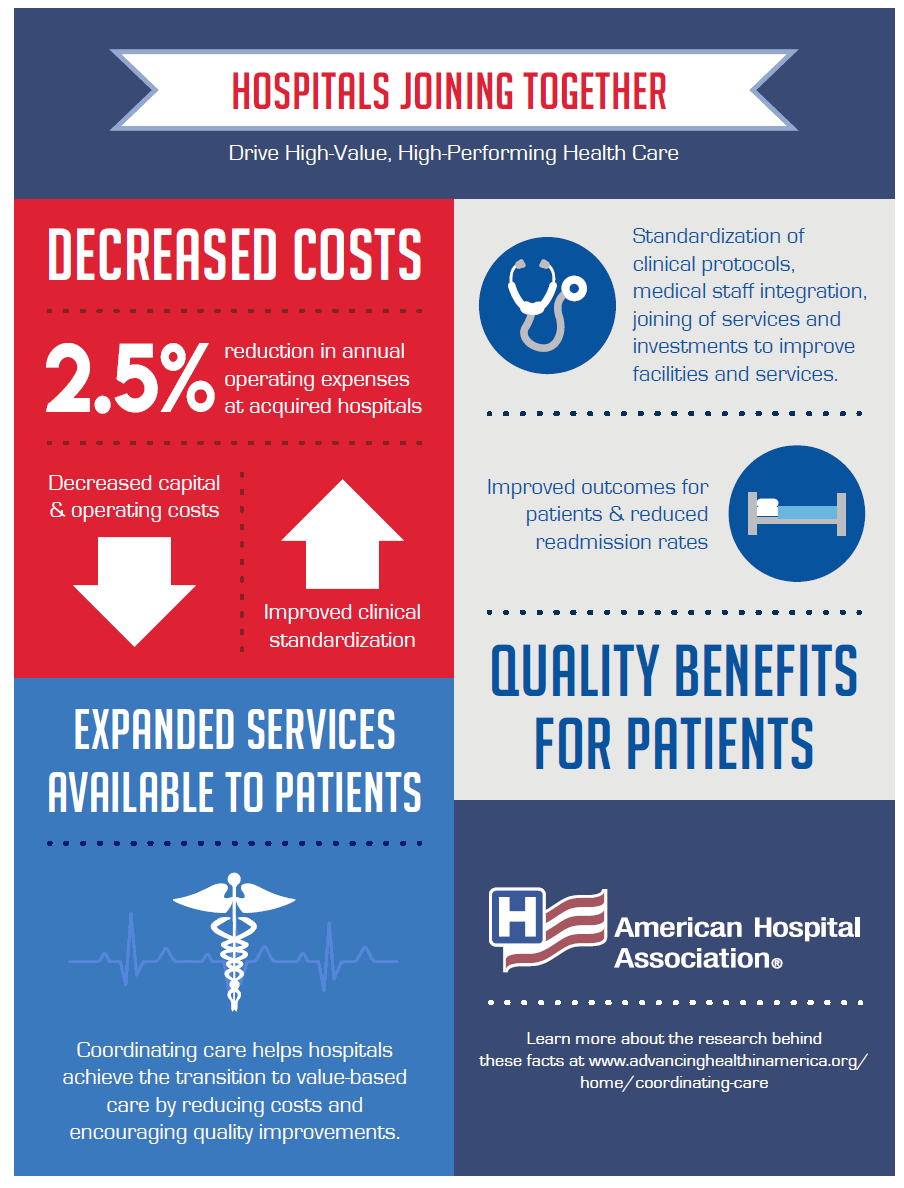Summary
Recent trends in the healthcare industry have demonstrated that mergers are an effective means for organizations to manage costs, increase efficiency, and provide optimal and accessible care to populations. Hospital consolidation has reached a peak in the last five years, with the top 10 health systems controlling 24% of the market share. The consolidations occur to regulatory, technology, and market dynamics, with a particular emphasis on financial pressures and the need for transformation of healthcare delivery which is difficult to achieve as an independent facility (Prevost et al., 2020).
Justification

The merger is justified as it can benefit both healthcare organizations significantly. Research demonstrates that consolidation leads to improved coordination of care, commonly resulting in a higher quality of care service and better outcomes (Schmitt, 2017). In turn, costs are reduced in the process and institutional stability is established, which helps to achieve economies of scale and improve access to capital or combined resources for optimal synergy (Schmitt, 2017). Those opposing the merger would argue that the lack of competition due to the merger would lead to declining quality and a hike in prices. Negotiations may lead to compromises in certain areas to reduce expenses, while in others, standards may be lowered for one or the other organization (Beaulieu et al., 2020).
The argument against the merger is strong in terms that just because services are duplicated, it still gives patients the right to choose where to receive treatment. However, if one of the hospitals took the leadership position and inherently buy out the other, it should be the GWHC. It is larger, more developed, spreading over several states, and has a strong core administrative system and central office support. It is able to take on the responsibility of added patients and the bureaucratic and practice elements that arise in the context of a merger without much disruption to healthcare services. The opposing argument in favor of Tanner Medical taking leadership is that the hospital has a greater awareness of local community and consumer medical needs. It is intimately tied with the community and patients in many ways, able to provide the best patient-centered care.
Stakeholder Impact
Patients
Patients may see changes in their quality of care in either direction. After the merger, it will be operating as one organization with universal standards, giving patients little choice.
Employees
Employees may see layoffs as positions become redundant due to duplication or otherwise. Overall, employees in a merged organization will have much smaller influence and advocacy as the merged management will control all affairs.
Local communities
Communities may benefit overall due to the synergy of resources that will become possible with the merger. Under one management, it will be much more effective to distribute healthcare resources within the local area as appropriate to achieve optimal efficiency.
Payers
Healthcare costs will likely continue to rise in accordance with industry trends. The new organization will justify raising costs and expenses. This may limit access to affordable care in the rural community.
Mission and Values
Elements such as vision, mission, and values serve as cornerstones to developing strategy and overseeing its execution. For example, the mission provides a starting point, vision is inherently the destination, and an organization’s values are guidelines that it seeks to follow. Without these, strategic plans can be erratic and not focused. Without a fundamental purpose, health organizations cannot plan for the future and strategically implement decisions (Regan, 2012). For example, when there is a misalignment between the values and culture of a healthcare organization, it can lead to negative outcomes. Therefore, an organization valuing the safety and care of patients, but choosing not to hire nurses to reduce costs amid low-profit margins, is jeopardizing its own organizational ethics.
Balancing Interests
One strategic means of balancing organizational and community interests is to adopt a virtue of social responsibility in hospital governance. Social responsibility includes the protection of all stakeholders involved in the deliverance of healthcare (Brandão et al., 2012). This allows for the organization to continue operating with its own interest in mind but evaluate strategic decisions in the light of the community and society. Another way is to invite community stakeholders in the decision-making process, communicating the interests of the public and advocating, which then helps hospital management to guide decisions in the marketplace in a way that can serve both the hospital and the community.
References
Beaulieu, N. D., Dafny, L. S., Landon, B. E., Dalton, J. B., Kuye, I., & McWilliams, J. M. (2020). Changes in quality of care after hospital mergers and acquisitions. New England Journal of Medicine, 382(1), 51–59. Web.
Brandão, C., Rego, G., Duarte, I., & Nunes, R. (2012). Social responsibility: A new paradigm of hospital governance? Health Care Analysis, 21(4), 390–402. Web.
Prevost, T., Gerhardt, W., Skillrud, I., & Mukherjee, D. (2020). The potential for rapid consolidation of health systems. Deloitte Insights. Web.
Regan, S. (2012). Strategic planning framework: The importance of the mission. Becker’s Hospital Review. Web.
Schmitt, M. (2017). Do hospital mergers reduce costs? Journal of Health Economics, 52, 74–94. Web.